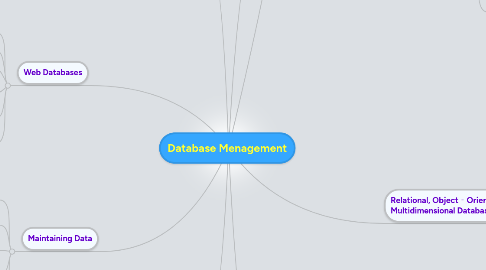
1. The Hierarchy of Data
1.1. Data is organized in layers – Files, records, fields, characters
1.1.1. A character is one byte – Numbers, letters, space, punctuation marks, or other symbols
1.1.2. A field is a combination of one or more related characters – Field name – Field size – Data type
1.1.3. A record is a group of related fields – A primary key uniquely identifies each record
1.1.4. A data file is a collection of related records
2. Database Management Systems
2.1. A data dictionary contains data about each file in the database and each field in those files
2.2. A DBMS provides several tools that allow users and programs to retrieve and maintain data in the database
2.3. A query language consists of simple, English‐like statements that allow users to specify the data to display, print, or store
2.4. Query by example (QBE) provides a GUI to assist users with retrieving data
2.5. A form is a window on the screen that provides areas for entering or modifying data in a database
2.6. A report generator allows users to design a report on the screen, retrieve data into the report design, and then display or print the report
2.7. A DMBS provides a variety of techniques to restore the database to a usable form in case it is damaged or destroyed
3. Maintaining Data
3.1. File maintenance refers to the procedures that keep data current
3.2. Users add new records to a file when they obtain new data
3.3. Users modify a record to correct inaccurate data or update old data
3.4. When a record no longer is needed, a user deletes it from a file
3.5. Validation compares data with a set of rules or values to find out if the data is correct
4. Web Databases
4.1. Shop for products or services
4.2. Buy or sell stocks
4.3. Search for a job
4.4. Make airline reservations
4.5. Register for college classes
4.6. Check semester grades
5. Database Administration
5.1. Employees should learn how to use the data in the database effectively – Interact with database – Identify new data for the database – Maintain the database
5.2. New node
6. Databases, Data, and Information
6.1. Database
6.1.1. Collection of data organized in a manner that allows access, retrieval, and use of that data
6.2. Data
6.2.1. Collection of unprocessed items •Text • Numbers •Images • Audio •Video
6.3. Information
6.3.1. Processed data •Documents • Audio •Images Video
6.3.2. Processed data •Documents • Audio •Images Video
7. File Processing Versus Databases
7.1. File processing system
7.1.1. •Each department has its
7.1.2. own set of files
7.1.3. •Used for many years
7.1.4. •Have data redundancy
7.1.5. • Isolate data
7.2. Database approach
7.2.1. •Programs and users share
7.2.2. data
7.2.3. • Reduce data redundancy
7.2.4. •Improve data integrity
7.2.5. •Share data
7.2.6. • Allows easier access
7.2.7. • Reduces development time
7.2.8. •Can be more vulnerable
